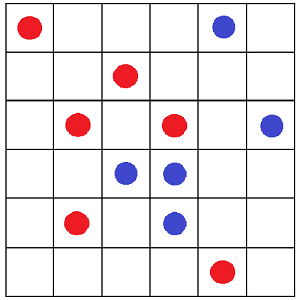Or search by topic
Number and algebra
Geometry and measure
Probability and statistics
Working mathematically
Advanced mathematics
For younger learners
Seeing Squares for Two



- Game
Here's a game to play with an adult!

How do you play?
You'll need an adult to play with.
You'll also need a set of blank grids, or you could use the tablet-friendly Seeing Squares interactivity.
Choose a different colour for you and the adult, and take it in turns to draw a dot on the grid - the player who is drawing the blue dots will go first. The winner is the first to have four dots that can be joined by straight lines to form a square. Squares can be any size, anywhere and can be tilted.
Can you work out a strategy? Justify why you think each move is a good one.
How do you know when you've made a square?
This game offers an excellent opportunity to practise visualising squares and angles on grids and also encourages children to look at strategies using systematic approaches.
Easier version: start by drawing examples of different squares on the grid, and discuss wrong or omitted solutions. Build up gradually from a 4x4 to 5x5 to 6x6 grid.
Harder version: try increasing the size of the grid.
Repeat the game, aiming to find a winning strategy, then talk together about how it was found.
There's a classroom version of this game here.
You may also like
Geoboards
This practical challenge invites you to investigate the different squares you can make on a square geoboard or pegboard.

